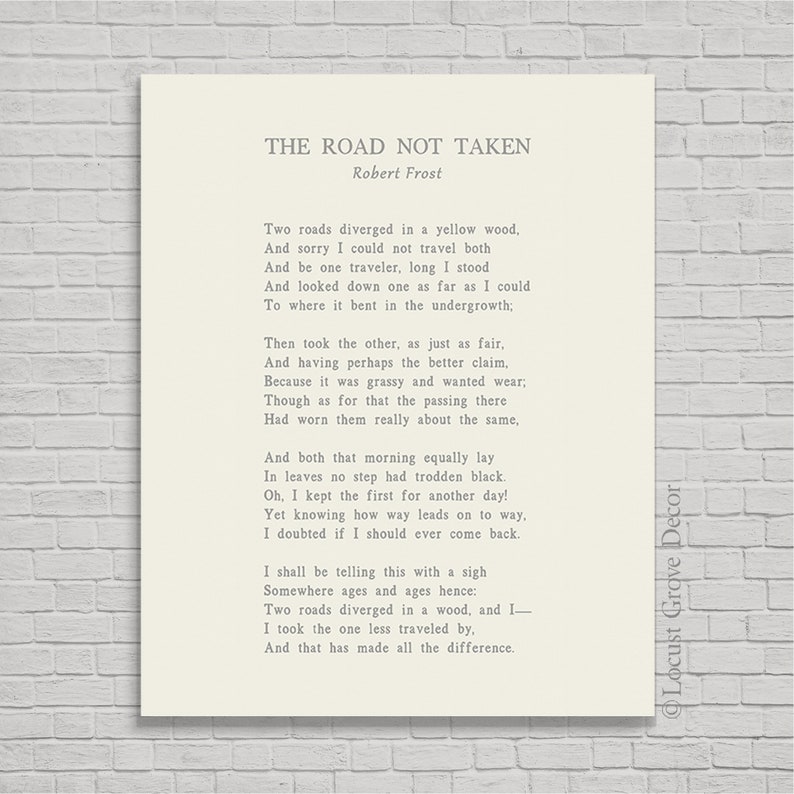
(v) how way leads on to wayĪlthough the traveller wanted to explore both the roads, he decided to take the less frequented one and keep the other one for future. So he finds that the freshly fallen leaves had not been walked over by anyone and hence they had not turned black and looked equally attractive and fresh.

The traveller was travelling in the morning. Here, the poet is using contrast and antithesis to express his repentance of having to make a choice as both options seemed to be equal. To the traveller both the roads that morning seemed to be used almost the same. The passing there refers to the road on which people had trodden on the grass. Here, the road is personified as it seems to want people to travel on that road, so that it could also become worn out like the other one. The road was less travelled and was filled with grass. The autumn season is symbolic of the matured age of a man’s life. The leaves have turned yellow and are about to fall. The yellow wood is the wood during autumn. The problem of the traveller is that he is facing a dilemma and is unable to decide which road or choice to take. The road is the metaphor for the journey of life, and the fork in the road stands for choices in life’s journey. He comes to a point where the road diverges into two separate paths. Where does the traveller find himself? What problem does he face?Īns.The traveller finds himself in a wood during the autumn season. Repetition – ‘Two roads diverged in a’ (repeated I stanza 1 and 4).Repetition – ‘ Ages and ages’, ‘ and I / I took …’.Alliteration – ‘wanted wear’, ‘first for’, ‘then took’, ‘that the’.Anaphora – Repetition of ‘ and ‘ in lines 2, 3, 4.Symbolism – The roads symbolize the choices in our life.Metaphor – the divergent paths are metaphors for choices in life.Metaphor – the road is the metaphor for journey of life.He chose to take the less travelled road which made a difference in his life and decided his future. He then predicts that sometime in the distant future he would tell others with a sigh, that at some point in his life he had to make a choice between two options. Though, in his sub- conscious mind he knew that it was a futile thought, as one way leads to the other and it was extremely doubtful that he would get the chance to travel the other road. Therefore, the poet decided to keep the first well-travelled road for a later time and took the somewhat less frequented one. It was early in the morning, and the fallen leaves were still fresh not having been stepped upon and turned black with the impact. Though, afterwards he felt that both the roads were walked on almost the same by travelers. It wanted people to wear down the grassy road through use. He thought that it had a greater claim for travelers as it was grassy and wanted people to travel through it. Therefore, he looked as far as possible till the road curved among the bushes and was no longer visible.Īfter much contemplation he took the other road which looked just as good as the other. He wanted to travel through both the roads and felt sorry that he was unable to do so. He wanted to make the correct choice and therefore found himself in a dilemma about choosing the right one. As he walked through the wood he came across a diversion or a fork on the road. In the poem the poet describes his experience of a walk through the woods one autumn morning. The road is the metaphor of that journey and the diversions in the road stand for the different choices that one comes across as one travels through life. The poem ‘The Road Not Taken’ is about the choices that one makes in the journey of life. Frost, one of the best-known and most beloved American poets of the 20th century, won the Pulitzer Prize four times for New Hampshire (1924), Collected Poems (1931), A Further Range (1937), and A Witness Tree (1943).Īnd that has made all the difference. He avoided the poetic experiments of his time and was a poet of traditional verse forms and meter. Frost mostly wrote about the life and landscape of New England.



Robert Frost was born on March 26 th, 1873 in San Francisco and died in January 29, 1963.


 0 kommentar(er)
0 kommentar(er)
